What Kind Of Animal Is The Butterfly?
Butterflies are i of the well-nigh graceful and beautiful types of flight insects you will notice in your garden. All types of butterflies are benign insects because they pollinate flowers and feed on common garden pests. Near people are familiar with the monarch butterfly. Still, there are some xviii,500 species of butterflies in the world that come in all shapes, sizes, and colors. From the many thousands of butterfly species in the globe, about 700 are native to Due north America.
The length of fourth dimension collywobbles alive depends on their species and activity. Some butterfly species can alive for many months and migrate huge distances. Other types of butterflies may only live for a few weeks.
In this article, you will learn how to place the many types of butterflies that are ordinarily found in woodlands and summertime gardens.
What do Butterflies Symbolize?
Collywobbles fluttering around gardens are synonymous with warm summer days. Yet, some people attach special symbolism or pregnant to butterflies.
For example, in Asian cultures, butterflies have come to mean long life or love. In Christianity, the alter of the caterpillar into a butterfly symbolizes the resurrection when the caterpillar "dies" and the butterfly is "reborn" in a different body.
In some cultures, black butterflies are viewed as an omen of bad news, having a cerise butterfly fluttering around you tin mean proficient news, or white butterflies can mean skilful luck.
How to Place a Butterfly
Collywobbles are a type of invertebrate insect with 4 wings that are usually brightly colored. These animate being types belong to the grade Insecta in the lodge Lepidoptera (butterflies and moths both belong to this social club). Butterflies are grouped into half-dozen families, and moths are in the family Hedylidae.
Like all other insects, collywobbles have six legs and iii main body parts: head, thorax (chest or mid section) and belly (tail end). Butterflies besides have two long antennae on their heads and they besides have an exoskeleton.
All butterflies beginning life as creeping caterpillars earlier metamorphosis. In fact nigh types of caterpillars bear no resemblance to the beautiful insects they get. For example, the famous orange and black monarch butterfly is a long light-green caterpillar with black and yellow stripes.
Although some types of caterpillars sting, collywobbles are completely harmless and don't seize with teeth or sting people. This means that it's fine to gently handle butterflies to identify them without fear of being stung.
Usually, male collywobbles are identified by their slender bodies and they may take different wing markings. Female butterflies tend to have a larger rounded belly in comparing to male collywobbles. Also, wing markings of male person and female collywobbles may be different. For case, male monarchs have a black dot near the base of each of their hind wings whereas the females don't.
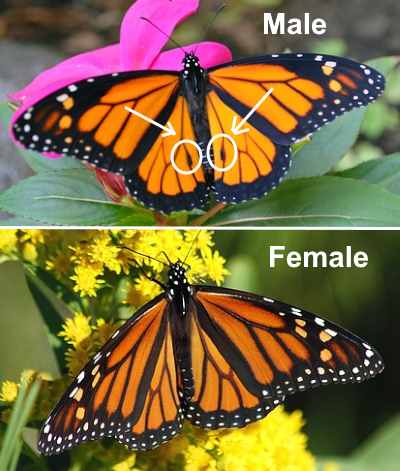
Male and female monarch butterfly identification
Most butterflies in North America and Europe are medium-sized insects. The largest species of butterfly is the Queen Alexandra's birdwing with a wingspan of nearly 10" (25 cm). The smallest butterfly is the Western Pygmy blue from Africa which just measures 0.five" (1.3 cm) across.
Identification of moths vs. butterflies
It is mostly easy to tell the difference betwixt moths and butterflies. Of course, some moths are also very colorful but they have dissimilar characteristics. For example, moths generally feed at night rather than in the mean solar day time. Also, butterflies residue with their wings in the closed position and moths generally proceed their wings open when resting. Also Butterflies have thin and long antennae, whereas moths have feathery and shorter antennae.
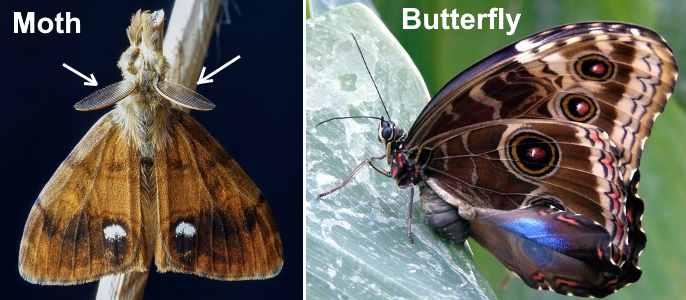
Nearly butterflies have sparse slender antennae while moths often have feathery shorter antennae
Main Families of Butterflies
All butterfly species are classified by the family unit they vest to. Collywobbles in some groups have common identifying features. The main families of butterflies are as follows:
The Nymphalidae family has around 6,000 species of butterflies and include monarchs, admirals, emperors, and tortoiseshells.
Butterflies in the Lycaenidae family contain pocket-sized species of brightly-colored butterflies and there are likewise effectually half dozen,000 different species.
Hesperiidae, or skippers, are a family of small butterflies that frequently have antennae pointing backward.
Papilionidae collywobbles are identified by wings that seem to have small-scale tails on them.
Pieridae is a family of butterflies from Africa that contains near 1,100 species.
Riodinidae is a group of butterflies with interesting metal colors on their wings. They are likewise called metalmark collywobbles.
Types of Collywobbles With Pictures and Names
Permit'southward expect in more than detail at some of the most mutual butterflies you are probable to see flight around your garden during warm sunny days.
Monarch Butterfly

The monarch is a popular butterfly with black and orange wings and white spots
The well-nigh iconic butterfly is the monarch butterfly (Danaus plexippus) with its orange wings, blackness veins, and white markings. They are besides called 'common tiger' butterflies, 'the wanderer,' and 'milkweed butterflies.' Monarchs take a wingspan of 3.5" to 4" (9 – 10 cm) and they rest with their wings closed.
Butterfly identification
Monarchs are native to Due north America and certain parts of Fundamental and Southward America. These orange and blackness collywobbles are also plant in Commonwealth of australia, North Africa, and islands in the Pacific Ocean. Monarchs are also famous for migrating thousands of miles.
Red Admiral Butterfly
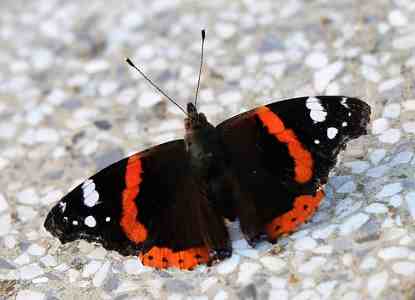
The blood-red admiral is a type of medium-sized butterfly with black and orangish wings and white spots
The carmine admiral butterfly (Vanessa atalanta) has hitting blackness or brown wings with vivid orange/cerise and white markings. This is somewhat smaller than the elegant monarchs, and they accept a smaller wingspan of 2" (v cm).
Butterfly identification
Reddish admirals are commonly found in woodlands in North American and Europe. You will ordinarily notice these butterflies resting on stinging nettles and feeding on the appropriately named butterfly bush (Buddleia).
Blackness Swallowtail Butterfly
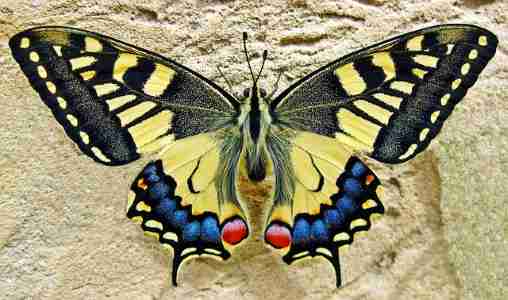
The black swallowtail is a large beautiful butterfly with black and yellow wings, and ruby and blueish markings
Some of the largest species of collywobbles in North America are from the genus Papilio. The black swallowtail (Papilio polyxenes) is an especially striking butterfly in the family unit Papilionidae. Its wings are black with xanthous markings or dots on the hind wings. There are as well beautiful blue and ruddy markings on the base of its hind wings.
As with about butterflies from this family unit, there are also tails on its hind wings.
Common names for the black swallowtail include 'parsnip swallowtail' and 'American Swallowtail.'
Giant Swallowtail
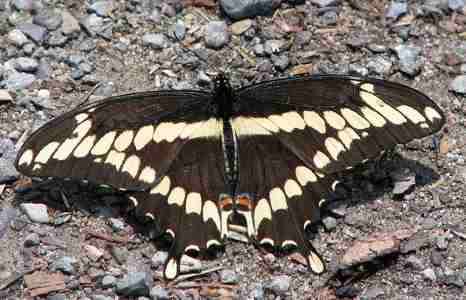
The big sized wings of the swallowtail butterfly are black with xanthous bands and pocket-size red dot
As its proper name implies, the giant swallowtail (Papilio cresphontes) is the largest in the family Papilionidae and information technology is besides the largest species in Due north America. Male person behemothic swallowtails have an average wingspan of upward to v.viii" (15 cm). Their striking black and yellowish appearance look stunning against dark-green foliage in summer gardens.
Butterfly identification
Like all butterflies in the genus Papilio, the giant swallowtail has tails on its hind wings. These give the butterfly wings a pointed appearance. In that location is a thick yellow stripe beyond its forewings and yellow marker along the edges of its hind wings. One of the identifying features of the giant swallowtail is its cherry-red and bluish markings on towards the center and base of its hind wings.
Crimson-Spotted Purple Butterfly

Limenitis arthemis consists of two master groups: white admirals (left) and crimson-spotted purples (correct) that mimic the poisonous pipevine swallowtail butterfly
The red-spotted purple butterfly (Limenitis arthemis) is an interesting butterfly every bit it has developed to mimic the appearance of other collywobbles. This butterfly in the family unit Nymphalidae, which also includes the 'white admiral.'
Butterfly identification
Although named a 'crimson-spotted' butterfly, these beautiful flying creatures can have blackness, blueish, or red wings. The grouping of white admirals has a white ring on the underside and topside of the wings. The other group of this species, the cerise-spotted purples, don't have these markings.
Information technology is difficult to draw exactly this blazon of butterfly as there are many hybrids in this species.
Tiger Swallowtail Butterfly
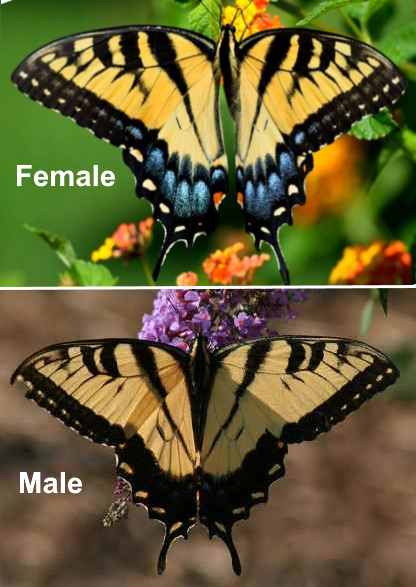
Male person tiger swallowtails have blackness and yellow wings while females likewise have blue markings on the hind wings
Some other of the beautiful species of butterfly from the family unit Papilionidae is the tiger swallowtail (Papilio glaucus). This tailed butterfly has yellowish and black patterns with "tiger" stripes on the upper-side of its forewings. In the summer and autumn, y'all can often find tiger swallowtails on asters and sweet peas.
Butterfly identification
I way to tell the difference between male and female tiger swallowtails is their distinctive wing markings. The female person species has blue markings on the lower function to the hind wings whereas the males have a blackness band on their wing edges.
Pipevine Butterfly
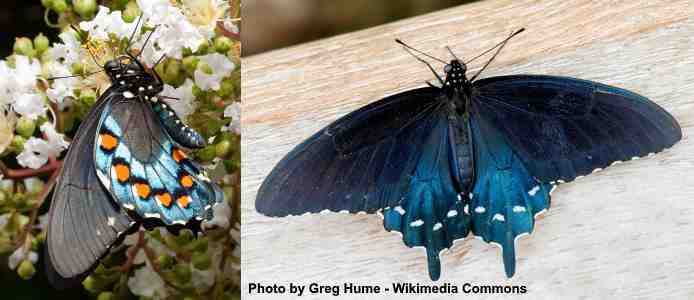
The beautiful Pipevine butterfly has black and bluish wings with orange spots under its wings
I of the most striking collywobbles yous will come across is the beautiful pipevine butterfly (Battus philenor). This swallowtail has black wings with iridescent blueish markings on its hind wings. You will besides notice interesting orange spots with blackness outlines betwixt the veins underside the wings.
Butterfly identification
Pipevine swallowtails are generally institute in forest biomes in North and Central America. Like many butterflies in the Papilionidae family, pipevines are quite large. Their black and bluish wings have a wingspan of between 2.8" and five.1" (7 – 13 cm).
Orangish Sulphur Butterfly
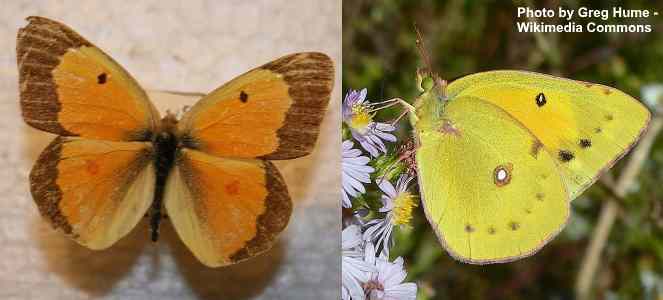
The Orange Sulphur butterfly has orangish and brown wings (left) and yellow colored wings on the underside (correct)
From the family unit Pieridae, the orange sulphur butterfly is found in North America, Canada, and Mexico. This species of butterfly from the genus Colias is closely related to clouded yellows and other overcast sulphur butterflies.
Butterfly identification
The orange sulphur butterfly can be identified by its orange rounded wings and dark-brown edging along the edges of the forewings and hind wings. You will also detect a single black or chocolate-brown dot on each of the forewings and an orange dot on the hind wings. In some cultures, if you have an orangish butterfly fluttering around y'all information technology can symbolize joy, passion, or a reminder to be positive.
Clouded sulphur collywobbles are like, just have pale flossy colored wings.
Zebra Longwing Butterfly
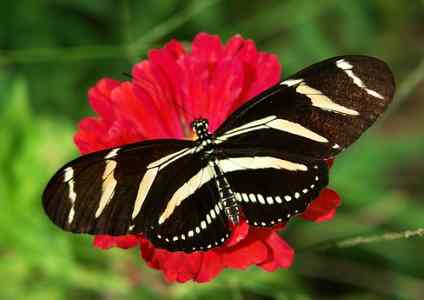
The zebra longwing butterfly has black and white striped wings with white dots
The common name of the Heliconius charithonia is zebra longwing butterfly due to its blackness and white striped wing patterns. These cute butterflies from the family Nymphalidae are generally constitute in Texas, Florida and Southward and Central America.
Butterfly identification
The zebra longwings take a wingspan of 2.7" to 4" (7 – 10 cm). The wings are black with a white band running laterally and a few diagonal ones on the wings. Looking up close at pictures of the butterflies, you lot will notice that some of the stripes can be yellowish. At that place is also a row of white dots on the base of the blackness hind wings.
Northern Pearly-Eye Butterfly
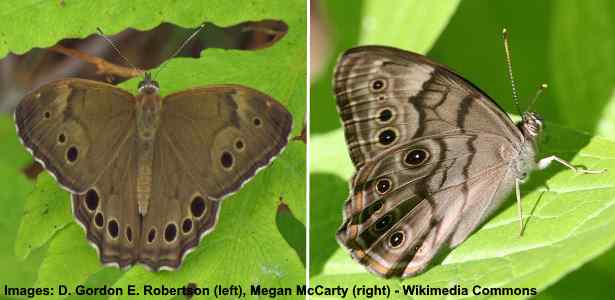
The Northern pearly-eye is a small-medium sized butterfly with wingspan of 1.vii" to 2.6" (iv.3–6.7 cm)
Northern pearly-eye butterflies (Enodia anthedon) are pretty butterflies that inhabit the forests of North America. The identifying feature of this pocket-sized butterfly species is the eye-like markings on the light brown ventral (underside) wings. The dorsal (upperside) wings are a brown-gray color with a row of black dots along the edges.
Butterfly identification
Despite its pretty advent, northern pearly-eyes like to feed on dung, fungi, and roadkill. In forests, you volition often find them on birch, poplar, and willow trees.
California Sister Butterfly
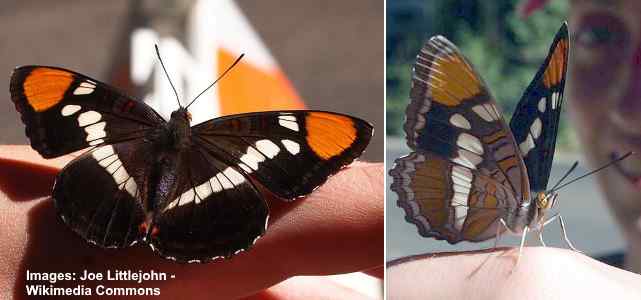
The California sis butterfly has black wings with white bands and orange markings
Some other of the types of black butterflies is the California sister butterfly (Adelpha californica). These big butterflies of the family Nymphalidae are fast flyers and accept a wingspan of up to 4" (ten cm). As its name suggests, this elegant butterfly species is found in California and the western coast of the U.Due south.
Butterfly identification
To identify the California sister butterfly, wait for its orange patches on the tips of the forewings. There is as well a white diagonal band on the wings. These markings are repeated on the underside of the wings. You will also notice that the dorsal wings may have orange, white, blue, and brownish coloring.
Milbert'due south Tortoiseshell Butterfly
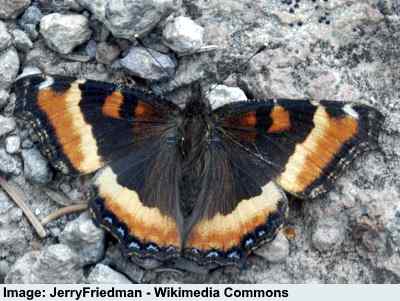
Milbert's tortoiseshell butterflies are commonly found in wet and moist areas
Milbert's tortoiseshell butterfly (Aglais milberti) is also called the fire-rim tortoiseshell and is a single species in the genus Aglais belonging to the family unit Nymphalidae. This small butterfly species is often seen darting through woodlands.
Butterfly identification
Looking at the Milbert's tortoiseshell, you will notice identifying marks such as orange and foam-colored bands forth the wing edges. The dorsal wings are more striking due to the contrast of dusty-orange on blackness. The ventral wings are a duller, more chocolate-brown-like color.
The Buckeye Butterfly
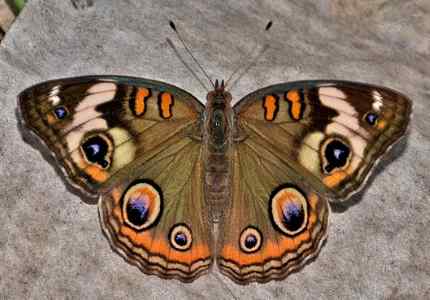
I of the most beautiful butterflies is the buckeye butterfly with its colorful eye-like markings
One of the nearly delightful butterflies in Due north America is the buckeye butterfly (Junonia coenia). The dark-brown wings take big centre-like markings on them which assistance ward off predators. Other identification marks on its wings are patches of orange, white, and hints of bluish colors. They have a wingspan of around ii" (5 cm).
On warm summer days, yous will frequently run across buckeyes on snapdragons, plantains, and other brightly-colored flowers. Interestingly, the buckeye butterflies prefer to feed on nectar from yellow flowers.
Question Mark Butterfly
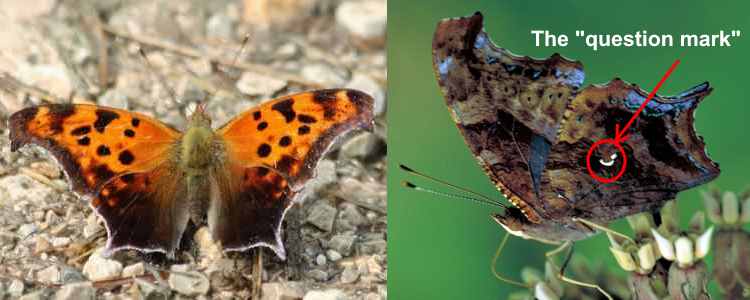
The question marking butterfly gets its name due to the white marking on the underside of the hind wing
The question mark butterfly (Polygonia interrogationis) is often found fluttering in open spaces and in wooded areas. They take an interesting fly shape with pointed tips and an uneven edge. These are medium-sized collywobbles that have a wingspan of between 1.8" and 3" (four.5 – 7.half-dozen cm).
'Question marks' are classified as a blazon of orange butterfly. Their fiery-colored orange wings have black dotted markings and a thin white border. The underside wings of these flying insects are a completely different color. These are brown and the pointed, jaggy wings that await similar a dead leaf when the butterfly closes them. This provides first-class camouflage to protect it from predators.
Painted Lady Butterfly
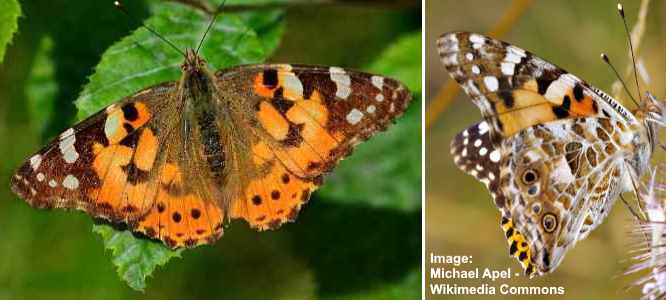
The painted lady is a common butterfly and can exist institute in America, Asia, Africa and Europe
One of the most mutual butterflies in the world could be the gorgeous painted lady butterfly (Vanessa cardui). The butterfly is too named the 'cosmopolitan' butterfly due to its widespread distribution.
In some means, the painted lady is similar to the monarch with orangish, blackness, and white markings. Notwithstanding, the veins on this butterfly's wings are not equally pronounced. The orangish forewings have black, brown, and white patches at their tips. The hind wing markings are 2 or iii rows of tiny black or brown dots.
When the painted lady closes its wings, it looks like a completely dissimilar species. The underside of the wings is a calorie-free-brown color with white markings with conspicuous eye-like dots. These features act both as camouflage every bit they wait like bird droppings on a leaf and the centre marks scare off would-be predators.
Glasswing Butterfly
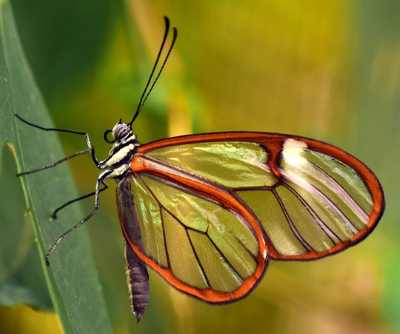
The glasswing butterfly is easily identified past its transparent wings with orange line around the edges
I of the most unique butterflies in the world may be the glasswing butterfly (Greta oto). Identification of this butterfly species is easy with its four transparent wings with the only coloration around the edges. The butterfly also looks prissy and delicate due to its slender body.
Unremarkably constitute in warmer climates such equally Texas, California, and South America, glasswings are a joy to find. They are medium-sized insects with the largest species having wingspans of ii.4" (6 cm).
Cabbage White
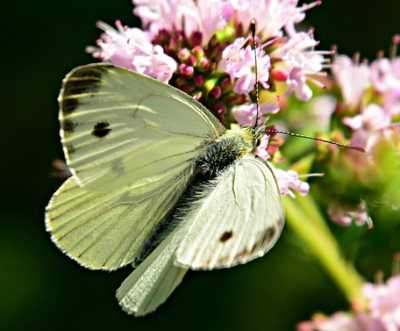
The cabbage white is a very popular and mutual butterfly in many gardens
1 of the most well-known white butterflies is the cabbage white (Pieris rapae). Although native to Europe, North Africa, and Asia, cabbage butterflies are also establish in Due north America and Australia. They are smaller than other types of collywobbles as their wingspan tin can be every bit modest as ane.3" (3 cm).
Butterfly identification
Identification of cabbage white butterflies is past their white-colored wings with black dots on them. To tell males and females autonomously, you tin can observe the black markings on the white wings. The males accept only one black dot on each fly and the females accept more.
You volition often discover cabbage whites feeding on asters. However, as green-colored caterpillars, cabbage white larvae tin can destroy cabbage crops by munching their way into the centre of the cabbage head.
Great Spangled Fritillary

The swell spangled fritillary is a type of pretty black and orange butterfly
Bright orangish wings help identify the great spangled fritillary butterfly (Speyeria cybele). The orange colors on the forewings and hind wings have an almost glowing appearance. The orangish wings also take rows of black dots and dashes between the black veins. The center of the wings closer to the body are in darker shades of orange, giving this a truly spectacular look.
The proper noun of this beautiful butterfly comes from the checkered blackness patterns on the orangish wings.
The dorsal wings are just every bit spectacular. When the butterfly rests and folds its wings up, you lot will notice that the wings are calorie-free brownish with irregular white markings. This is another camouflage machinery to trick predators.
Related articles:
- Beautiful Types of Insects with Pictures
- Amazing Types of Caterpillars with Helpful Identification Chart
- Amazing Types of Ladybugs With Pictures
Read Side by side
Source: https://leafyplace.com/types-of-butterflies/
Posted by: millerpithenclacke.blogspot.com

0 Response to "What Kind Of Animal Is The Butterfly?"
Post a Comment